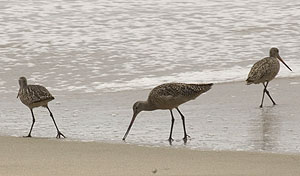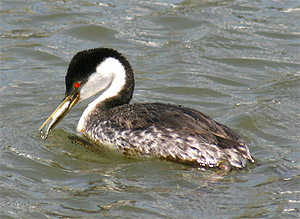
|
|||||||||||||||
|
| |||||||||||||||
Storm debris litters the high tide line A walk on almost any sandy beach in January or February is an adventure in beachcombing. By this time of year, many Central Coast beaches will have thick deposits of driftwood, kelp, and other organic debris, as well as trash (especially plastic). Note: The kelp you see on winter beaches often includes not just the typical giant kelp, but also the long, sinuous tubes of bull kelp and the rubbery bouquets of sea palms. These are annual kelps, whose old, weakened stalks are often broken or pulled off their holdfasts by winter storm waves. The "bathtub rings" of debris you see on beaches after storms may look unsightly, but all that dead and dying material provides essential food for scavengers such as beach hoppers (a type of amphipod). One of the most common of these is Megalorchestia californiana—the California long-horned beach hopper. These small crustaceans hide in their burrows on sunny days, but emerge on overcast days and at night to eat bits of seaweed and other debris. Beach hoppers also provide food for shorebirds such as sanderlings, which spend the winter along the Central Coast . Beach hoppers must be especially careful not to be caught by winter waves when they colonize beach wrack in the winter time. Although beach hoppers have gills, they cannot survive being immersed in seawater for long periods of time. Although beach hoppers are the most common animals found in beach-wrack, they share this food source and habitat with 35 different species of beetles (mostly predatory) and 11 species of flies (whose larvae feed on the wrack) . In fact, kelp wrack communities include enough animals to fill an entire book, including mites, spiders, pseudoscorpions, centipedes, wasps, and other insects. Organic beach debris also acts as fertilizer in the sterile beach sand, helping dune plants such as sea rocket, which recolonize the upper beach during spring. Some beach plants, especially non-native ones such as sea rocket, iceplant, beach morning glory, and European dune grass, even use winter storms as a means of dispersal and propagation. When winter storms erode the dunes, seeds, rhizomes, or entire plants may be carried out to sea. Some of these plants or their seeds are able to survive at least short-term immersion in salt water. When they are washed up on a new beach, they may be able to put out roots and grow again in spring. Beach sand moves offshore When planning a winter-time beach walk, it's best to go at low tide, because there may not be any beach at high tide. In fact, as in the tide pools, many beaches are at their lowest levels of the year. In addition, most beaches will be low and flat. Sometimes there will be no berm--the break in slope where the steep foreshore meets the level back beach. But fear not for the beach sand. It is not gone forever, but has simply been deposited in sand bars offshore. Such bars typically run parallel to shore, and are separated by "troughs" of deeper water. You can see this from shore as the waves break on the bars and then "back off" when they hit the troughs. You may also see strong rip currents running out to sea through deep channels cut at right angles to the bars. Such rip currents are most likely to form during heavy surf, but the channels they cut through the bars persist even after the storm surf has subsided. Beach animals adapt to winter surf Many beach animals, such as surf perch and sand dollars, move into deeper water in the winter time, to avoid the worst of the turbulence of the winter storm waves . Others, such as mole crabs, hunker down deeper in the sand and wait for the beach to rebuild later in spring. On the land side, animals such as beach hoppers (amphipods) move up into the dunes to avoid being swept out to sea when sand is stripped off the beaches . Shorebirds overwinter on Central Coast beaches  Marbled godwits feeding at the edge of the wet sand. (Source: Kim Fulton-Bennett) January and February are good months to watch flocks of beach birds feeding at the water's edge. At low tide, the flat beaches of winter provide perfect foraging habitat for sanderlings, godwits, gulls, and other shore birds that spend their winters feeding along the Central Coast. Such birds follow the retreating tide, snagging mole crabs, small clams, and animals that have been dug up and carried ashore by storm waves. By the end of February, these winter-resident shorebirds will be joined by the first spring migrants, which use Central Coast beaches as feeding stops. For example, you may see flocks of 50 to 100 sanderlings flying rapidly northward along the coast at this time of year. These long-distance migrators are covered in more detail in April. These flocks often land on a promising stretch of sand, feed frantically for 15 or 20 minutes, and then take off and resume their migration up the coast. Diving birds congregate just off the beach January and February are good times of year to see flocks of surf scoters (Latin name) swimming in channels between the sand bars, or hunting just outside the surf zone. These small duck-like birds brave the churning waves (and may even use the wave turbulence) to hunt for mole crabs, which have moved into deeper water at this time of year. During February, hundreds of scoters may congregate in favorable feeding areas (such as off Moss Landing), fattening up in preparation for their long flight north to nesting areas during March and April.  Western grebe preparing to swallow a small fish. (Source: Steve Lonhart / SIMoN NOAA) A little farther out from the breaking, you may also see pairs of Western grebes (Aechmophorus occidentalis), with graceful necks, sharp, pointed beaks, and red eyes. When hunting, Western grebes actually leap up a few inches above the water's surface before diving down to hunt fish. With their small beaks, Western grebes can't swallow fish that are more than about an inch across. I once watched a Western grebe surface with a 3-inch-long juvenile flatfish in its beak. After trying repeatedly to swallow the fish whole, the grebe placed the (by this time immobile) fish back in the water and then stabbed at it repeatedly, using its sharp beak to chop the fish up into bite-sized pieces. |
